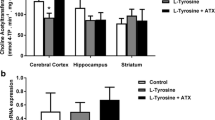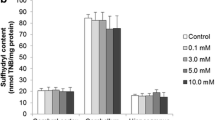Abstract
In the present study we investigated the action of vitamins E and C on the inhibition of acetylcholinesterase and butyrylcholinesterase activities provoked by arginine in cerebral cortex and serum of 60-day-old rats. Animals were pretreated for 1 week with daily intraperitoneal administration of saline (control) or vitamins E (40 mg/kg) and C (100 mg/kg). Twelve hours after the last injection, animals received one injection of arginine (0.8 μM/g of body weight) or saline. Results showed that acetylcholinesterase and butyrylcholinesterase activities were decreased in the arginine-treated rats. Furthermore, pretreatment with vitamins E and C prevented these effects. The data indicate that the reduction of acetylcholinesterase and butyrylcholinesterase activities caused by arginine was probably mediated by oxidative stress. Assuming the possibility that these effects might also occur in the human condition, our findings may be relevant to explain, at least in part, the neurological dysfunction associated with hyperargininemia and might support a novel therapeutic strategy to slow the progression of neurodegeneration in this disorder.
Similar content being viewed by others
references
Brusilow, S. W. and Horwich, A. 2001. Urea cycle enzymes. Pages 1909–1963, in Scriver, C. R., Beaudet, A. L., Sly, W. S., and Valle, D. (eds.), The Metabolic and Molecular Bases of Inherited Disease, 8th ed, McGraw-Hill, New York.
Iyer, R., Jenkinson, C. P., Vockley, J. G., Kern, R. M., Grody, W. W., and Cederbaum, S. 1998. The human arginases and arginase deficiency. J. Inher. Metab. Dis. 21:86–100.
Prast, H. and Philippu, A. 2001. Nitric oxide as modulator of neuronal function. Progr. Neurobiol. 64:51–68.
Dawson, V. L. and Dawson, T. M. 1996. Nitric oxide neurotoxicity. J. Chem. Neuroanat. 10:179–190.
Yun, H. Y., Dawson, V. L., and Dawson, T. M. 1997. Nitric oxide in health and disease of the nervous system. Mol. Psychiatry. 2:300–310.
Dawson, V. L. and Dawson, T. M. 1996. Nitric oxide in neuronal degeneration. Proc. Soc. Exp. Biol. Med. 21:133–140.
Law, A., Gauthier, S., and Quirion, R. 2001. Say NO Alzheimer's disease: The putative links between nitric oxide and dementia of the Alzheimer's type. Brain. Res. Rev. 35:73–96.
Buchmann, I., Milakofsky, L., Harris, N., Hofford, J. M., and Vogel, W. H. 1996. Effect of arginine administration on plasma and brain levels of arginine and various related amino compounds in the rat. Pharmacology. 53:133–142.
Wyse, A. T. S., Bavaresco, C. S., Bandinelli, C., Streck, E. L., Franzon, R., Dutra-Filho, C. S., and Wajner, M. 2001. Nitric oxide synthase inhibition by L-NAME prevents the decrease of Na+,K+-ATPase in midbrain of rats subjected to arginine administration. Neurochem. Res. 26:515–520.
Delwing, D., Delwing, D., Dutra-Filho, C. S., Wannmacher, C. M. D., Wajner, M., and Wyse, A. T. S. 2002. Arginine administration reduces catalase activity in midbrain of rats. Neuroreport. 13:1301–1304.
Reis, E. A., de Oliveira, L. S., Lamers, M. L., Netto, C. A., and Wyse, A. T. S. 2002. Arginine administration inhibits hippocampal Na+,K+-ATPase activity and impairs retention of an inhibitory avoidance task in rats. Brain Res. 951:151–157.
Everitt, B. J. and Robbins, T. W. 1997. Central cholinergic systems and cognition. Annu. Rev. Psychol. 48:649–684.
Olney, J. W., Collins, R. C., and Sloviter, R. S. 1986. Excitotoxic mechanisms of epileptic brain damage. Adv. Neurol. 44:857–877.
Mack, A. and Robitzki, A. 2000. The key role of butyrylcholinesterase during neurogenesis and neural disorders: An antisense-5′butyrylcholinesterase-DNA study. Prog. Neurobiol. 60:607–628.
Atack, J. R., Perry, E. K., Bonham, J. R., Perry, R. H., Tomlinson, B. E., Blessed, C., and Fairbairn, A. 1983. Molecular forms of acetylcholinesterase in senile dementia of Alzheimer type: Selective loss of the intermediate (10S) form. Neurosci. Lett. 40:199–204.
Bowen, D. M. and Dawison, A. N. 1986. Biochemical studies of nerve cells and energy metabolism in Alzheimer's disease. Br. Med. Bull. 42:75–80.
Fishman, E. B., Siek, G. C., McCallum, R. D., Bird, E. D., Volicer, L., and Marquis, J. K. 1986. Distribution of the molecular forms of acetylcholinesterase in human brain: Alterations in dementia of the Alzheimer type. Ann. Neurol. 19:246–252.
Giacobini, E., Spiegel, R., Enz, A., Veroff, A. E., and Cutler, N. R. 2002. Inhibition of acetyl-and butyryl-cholinesterase in the cerebrospinal fluid of patients with Alzheimer's disease by rivastigmine: Correlation with cognitive benefit. J. Neural. Transm. 109:1053–1065.
Tsakiris, S., Angelogianni, P., Schulpis, K. H., and Stavridis, J. C., 2000. Protective effect of l-phenylalanine on rat brain acetylcholinesterase inhibition induced by free radicals. Clin. Biochem. 33:103–106.
Kale, M., Rathore, N., John, S., and Bhatnagar, D. 1999. Lipid peroxidative damage on pyrethroid exposure and alterations in antioxidant status in rat erythrocytes: A possible involvement of reactive oxygen species. Toxicol. Lett. 105:197–205.
Tappel, A. L. 1972. Vitamin E free radical peroxidation of lipids. Ann. NY Acad. Sci. 203:12–28.
Burton, G. W. and Traber, M. G. 1990. Antioxidant activity, biokinetics, and biovailability. Ann. Rev. Nutr. 10:357–380.
Vatassery, G. T. 1998. Vitamin E and other endogenous antioxidants in the central nervous system. Geriatrics 53 (Suppl. 1):25–27.
Meydani, M., Macauley, J. B., and Blumberg, J. B. 1988. Effect of dietary vitamin E and selenium on susceptibility of brain regions to lipid peroxidation. Lipids. 23:405–409.
Clement, M. and Bourre, J. M. 1997. Graded dietary levels of RRR-gamma-tocopherol induce a marked increase in the concentrations of alpha-tocopherol in nervous tissue, heart, liver and muscle on vitamin-E-deficient rats. Biochim. Biophys. Acta. 1334:173–181.
Stöcker, R. 1994. Lipoprotein oxidation: mechanistic aspects, methodological approaches and clinical relevance. Curr. Opin. Lipidol. 5:422–433.
Wyse, A. T. S., Zugno, A. I., Streck, E. L., Matté, C., Calcagnotto, T., Wannmacher, C. M. D., and Wajner, M. 2002. Inhibition of Na+,K+-ATPase activity in hippocampus of rats subjected to acute administration of homocysteine is prevented by vitamins E and C treatment. Neurochem. Res. 27:1677–1681.
Ellman, G. L., Courtney, K. D., Andres, V., and Featherstone, R. M. 1961. A new and rapid colorimetric determination of acetylcholinesterase activity. Biochem. Pharmacol. 7:88–95.
Rocha, J. B. T., Emanuelli, T., and Pereira, M. E. 1993. Effects of early undernutrition on kinetic parameters of brain acetylcholinesterase from adult rats. Acta Neurobiol. Exp. 53:431–437.
Bradford, M. M. 1976. A rapid and sensitive method for the quantitation of microgram quantities of protein utilizing the principle of protein-die binding. Anal. Biochem. 72:248–254.
Turpaev, K. T. 2002. Reactive oxygen species and regulation of gene expression. Biochemistry (Mosc.). 67:281–292.
Bavaresco, C. S., Calcagnotto, T., Tagliari, B., Delwing, D., Lamers, M. L., Wannmacher, C. M. D., Wajner, M., and Wyse, A. T. S. 2003. Brain Na+,K+-ATPase inhibition induced by arginine administration is prevented by vitamins E and C. Neurochem. Res. 28:825–829.
Bickford, P. C., Gould, T., Briederick, L., Chadman, K., Pollock, A., Young, D., Shukitt-Hale, B., and Joseph, J. 2000. Antioxidant-rich diets improve cerebellar physiology and motor learning in aged rats. Brain Res. 866:211–217.
Cantuti-Castewlvetri, I., Shukitt-Hale, B., and Joseph, J. A. 2000. Neurobehavioral aspects of antioxidants in aging. Int. J. Devl. Neurosci. 18:367–381.
Jeyarasasingam, G., Yeluashvili, M., and Quik, M. 2000. Nitric oxide is involved in acetylcholinesterase inhibitor-induced myopathy in rats. J. Pharmacol. Exp. Ther. 295:314–320.
Hara, H., Kato, H., and Kogure, K. 1990. Protective effect of alpha-tocopherol on ischemic neuronal damage in the gerbil hippocampus. Brain Res. 510:335–338.
Anderson, D. K., Waters, T. R., and Means, E. D. 1988. Pretreatment with alpha-tocopherol enhances neurologic recovery after experimental spinal cord compression injury. J. Neurotrauma 5:61–67.
Sano, M., Ernesto, C., Thomas, R. G., Klauber, M. R., Schafer, S., Grundman, M., Woodbury, P., Growdon, J., Cotman, C. W., Pfeiffer, E., Schneider, L. S., and Thal, L. J. 1997. A controlled trial of selegiline, α-tocopherol, or both as treatment for Alzheimer's disease. New Engl. J. Med. 336:1216–1222.
Delwing, D., Chiarani, F., Delwing, D., Bavaresco, C. S., Wannmacher, C. M. D., Wajner, M., and Wyse, A. T. S. 2003. Proline reduces acetylcholinesterase activity in cerebral cortex of rats. Metab. Brain Dis. 18:79–86.
Reis, E. A., Zugno, A. I., Franzon, R., Tagliari, B., Matté, C., Lammers, M. L., Netto, C. A., and Wyse, A. T. S. 2002. Pretreatment with vitamins E and C prevent the impairment of memory caused by homocysteine administration in rats. Metab. Brain Dis. 17:211–217.
Author information
Authors and Affiliations
Corresponding author
Rights and permissions
About this article
Cite this article
Wyse, A.T.S., Stefanello, F.M., Chiarani, F. et al. Arginine Administration Decreases Cerebral Cortex Acetylcholinesterase and Serum Butyrylcholinesterase Probably by Oxidative Stress Induction. Neurochem Res 29, 385–389 (2004). https://doi.org/10.1023/B:NERE.0000013741.81436.e8
Issue Date:
DOI: https://doi.org/10.1023/B:NERE.0000013741.81436.e8




